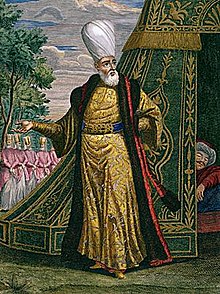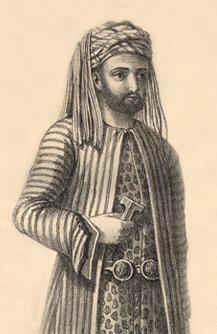

Agha (Turkish: ağa;[2] Ottoman Turkish: آغا; Persian: آقا, romanized: āghā; "chief, master, lord"[3]) is an honorific title for a civilian or officer, or often part of such title. In the Ottoman times, some court functionaries and leaders of organizations like bazaar or the janissary units were entitled to the agha title. In rural communities, this term is used for people who own considerable lands and are influential in their community. Regardless of a rural community, this title is also used for any male who is influential or respected.[2]
Etymology[edit]
The word agha entered English from Turkish,[3] and the Turkish word comes from the Old Turkic aqa, meaning "elder brother".[4] It is an equivalent of Mongolian word aqa or aka.[5]
Other uses[edit]
"Agha" is nowadays used as a common Persian honorific title for men, the equivalent of "mister" in English.[6] The corresponding honorific term for women is khanum which is also of Turkic origin.
See also[edit]
- State organisation of the Ottoman Empire
- Agha Petros
- Agaluk
- Aga Khan
- Agha of the Janissaries
- Kapi Agha
- Kizlar Agha
- Silahdar Agha
References[edit]
- ^ Narrative of Residence in Koordistan and on the Site of Ancient Nineveh, pages 66 and 214, Claudius James Rich, Published 1836, J. Duncan, 860 pages
- ^ a b "ağa". Türk Dil Kurumu Sözlükleri. Retrieved 10 July 2022.
- ^ a b "Online Etymology Dictionary". Etymonline.com. Retrieved 2017-06-30.
- ^ Turkish. "Aga | Define Aga at Dictionary.com". Dictionary.reference.com. Retrieved 2017-06-30.
- ^ "*Etimoloji: Kökenbilim, kelimelerin aslını ve evrimini inceleyen disiplin ~ EYun étymon "asıl" + logeía "bilim"". Nisanyansozluk.com. Retrieved 2017-06-30.
- ^ Khani, S., and R. Yousefi. "The study of address terms and their translation from Persian to English." (2014).
Well, that’s interesting to know that Psilotum nudum are known as whisk ferns. Psilotum nudum is the commoner species of the two. While the P. flaccidum is a rare species and is found in the tropical islands. Both the species are usually epiphytic in habit and grow upon tree ferns. These species may also be terrestrial and grow in humus or in the crevices of the rocks.
View the detailed Guide of Psilotum nudum: Detailed Study Of Psilotum Nudum (Whisk Fern), Classification, Anatomy, Reproduction